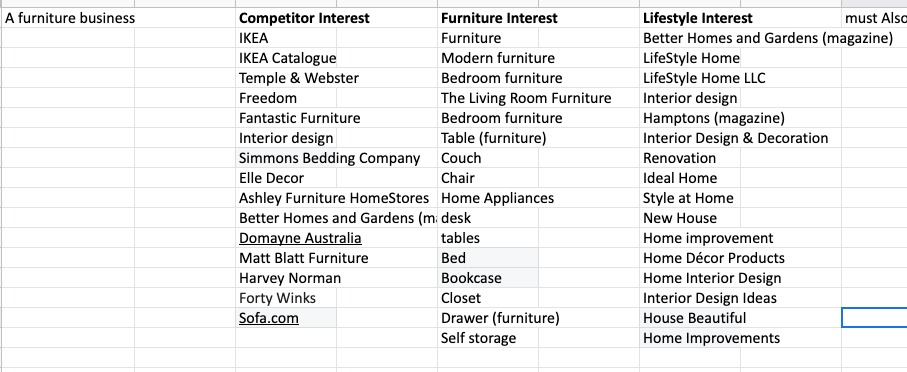Facebook Ads Detailed Targeting May Be Up To 33% Inaccurate (With Detailed Targeting Best Practices)
Table of Contents (Click to show/hide)









Facebook Ads Detailed Targeting Study
Are you thinking of increasing your business by using Facebook Ads Detailed Targeting? Do you have a question about whether it is accurate to target the right consumer for the product?
A research was conducted at the North Carolina State University to discover the answers to the following similar questions about Facebook Ads Detailed Targeting:
- In what way does Facebook determine user interests?
- Is Facebook able to accurately predict user interests based on their activity?
- Is Facebook's explanation of how inferred interests are derived accurately?
NC State researchers conducted several experiments to determine whether Facebook "interest" correlates with user activities and user interests from across the globe. Unfortunately, the outcome was far from encouraging.
Check Out Test Result in Seconds - TL;DR Version

Experiment 1.
As a first experiment, 14 accounts were created - a small sample size - that simply viewed content and scrolled through it to determine if those topics within the content consumed were subsequently pulled into the "Interest Categories" accounts. In addition, this study sought to determine which interests would be associated with newly formed accounts and determine the degree of accuracy of newly assigned interests.
The findings indicated that 33.22 percent of the inferred interests were incorrect or irrelevant. A PhD student at NC State, Aafaq Sabir, lead author of a study on the study and lead author of the paper, concluded, "The key finding here is that Facebook is aggressive in its interest inference."
Experiment 2.
NC State researchers sought to test them on a broader user sample to investigate the findings further. According to Amazon Mechanical Turk, the study participants came from "different parts of the world." Participants would then be asked about the validity of the interest data using a browser extension that extracts data from their Facebook accounts.
A new study found that 29.3% of the interests listed by Facebook for participants were not relevant to them. "That's similar to what we saw in our controlled experiments," said co-author Anupam Das, assistant professor of computer science at NC State.

Results of the study
Targeting Interest Categories on Facebook may be inaccurate by up to 33%.
What causes us to be concerned?
Advertising targeting is sometimes not as perfect as it could be. For example, by logging in, you can see what Google targets your ads to and what Facebook thinks you are interested in. Although no targeting is ideal, the study's 30-33 percent error findings are alarming.
Due to Facebook Ads Detailed Targeting interest being inaccurate, you might be wondering, "How do we market our product?". The following are some excellent tips for Facebook Ads detail targeting:
Powerful Facebook Ads Detailed Targeting Tips
Creating Interest Targeting Audiences
When you develop an interest profile, you combine numerous interests to form a picture of your target market. It's like imagining your dream person based on their hobbies!
I have three major strategies for "Detailed targeting":
- Interest stacking
- Interest layering
- A combination of both stacking and layering
Interest stacking
Separately testing interest categories is a smart method to stack interests. After determining which types perform best, you may focus on discovering keywords that produce the best results. For example, one ad set may be used to target competitors, while another could be used to target publications, celebrities, and a variety of other topics that are relevant to your chosen keywords. For example, assume you're in the activewear eComm industry. If you're offering sportswear that can be worn for various activities, it might be a good idea to target people interested in all of these sports and group them all together in one ad group.
Take one of my clients in the furniture e-commerce business. For example, I picked a collection of promising interest keywords into "Products," "Competitors," and "Lifestyle" categories and started testing them in upper-funnel campaigns in different ad groups. When it comes to the sales period, I will think about using the "people also match" feature to layer "Engaged Shoppers" to narrow the audience.


Interest Layering
Using interest layering, you may push Facebook to show your ad campaigns to the most relevant people who match multiple interests altogether in your target demographic. Because of the "AND" logic, this is achievable. Let's get back to business with the furniture business. You'd want to create targeting at the ad group level as Product Type, Competitors, Lifestyle Interests and other interested people in House & Garden Category. Furthermore, you can personalise your adverts to their preferences based on your chosen interest group. And then, You can utilise interest layering to attract "Engaged Shopper", "Black Friday", and "Cyber Monday" furniture prospects in your ads.
Pro Tip: Try experimenting with "Black Friday" and "Cyber Monday" Interest groups to determine which one has the best click-through rate. One of the Facebook Experts recommended that I remove the "Black Friday" and "Cyber Monday" in interest layering, but the CTR dropped immediately.
.png)
Interest stacking and interest layering combination
After conducting extensive interest targeting research, it's time to merge all of the beneficial interest keywords you've obtained. You can create numerous layers and add one or more interests within the layers by combining stacking and layering. Within each layer, a "OR" logic will be used. The "AND" logic is used between the layers. The audience with at least one interest in each group will see your adverts on Facebook. If your activewear company wants to promote soccer (European football) products, overlaying soccer-related interests with interest in sportswear will help you narrow down your target audience.
What should be the audience size?
When you ask marketers about the audience size, you'll probably get different responses. The problem is that there is no hard and fast rule for how big or small your audience should be. Instead, the size of your audience is determined by a variety of factors, including your ad aims and niche.
You can start leveraging lookalike audiences for the custom audience once your CA reaches 500.
For beginners, the usual audience size range is 50,000 to 200,000. This is a reasonable estimation when you have a small amount of pixel data. You can gradually increase the size of your audience once you've gained enough traffic to allow Facebook to target appropriate audiences.
Exclude audiences
Existing website visitors and previous purchases should be excluded from acquisition ad campaigns. If you want to reach out to new people with your brand, you should spend your impression budget on fresh and suitable audiences. You can also exclude custom or saved audiences and audiences based on demographics, interests, and behaviour.
Running an acquisition campaign on Facebook demands this because one of the platform's primary data points is previous website visits. People who have previously visited your website are the best audience segment for Facebook to show your advertising to. Warm traffic won't be important if the campaign isn't for re-engagement or retargeting but for acquisition. This is something that many newcomers ignore.
Cold traffic is one of the goals of acquisition campaigns. Because they're designed to introduce a brand to a new audience, it's crucial to keep customers who have already interacted with the brand out. Warm traffic will result in a larger audience size but lower engagement levels for your acquisition campaigns.
You can also filter out irrelevant demographics, interests, and behaviours. Assume you're a medical university looking to promote its medical studies. Practising doctors, medical school professors, and others down the line should all be on your list of excluded audiences. They have a very slim possibility of responding to your medical school ad campaign. Perhaps they'll click out of curiosity, but that'll be the end of it — irrelevant traffic.
Combine interests with demographics and behaviours
You may narrow your targeting options even further by combining niche-related interests with demographic data and behaviours and being extremely specific with interest targeting. If you're targeting particularly specific groups of interests, combining them with both can help you to reach a smaller but highly targeted audience.
This strategy may be particularly effective for wide interest keywords that you can't filter down while maintaining their original meaning. This will allow you to focus on showing your adverts to a higher likely-to-convert demographic. You can, for example, target people based on their gender, relationship status, educational level, life events, or purchasing habits.
Which other criteria would you use to locate your target audience if you operated an eCommerce jewellery business and wanted to advertise your rings? Because a ring might be a romantic gift, you could target people whose anniversary is approaching. When combined with a desire for rings, this audience might be a potent conversion driver.
Intersect lookalike audiences with interests
When you're targeting a large lookalike audience, there's a good chance your ad set will land up with a large and diverse audience. Even lookalike audiences, one of the most popular and effective means of targeting, may become less accurate as they grow in size.
Intersecting large lookalike audiences with interests is an excellent approach to limiting them. You can choose one or more interests as the foundation for filtering, and you'll get more relevant lookalikes - people that look like your clients and share their interests.
Note: However, this is not recommended by Facebook Expert (Facebook Expert I meant consultation directly coming from Facebook). It's claimed that that Lookalike audience should always has its own individual ad group instead of combining detailed targeting. It will create a mixed signal to the machine learning, hence worsen the result. Regardless, we should have confidence in machine learning and trust that big company like Facebook has this flexibility. I recommend you running a test before you ditch this strategy.
Detailed Targeting Tips For B2B
These audiences, which can be found under "More Categories" in the Detailed Targeting section, are composed of Facebook-identified employees of B2B enterprises with sizes ranging from 10-200, 20-500, and 500+ employees.
This creates a terrific huge seed audience rather than wasting time with Facebook's less-than-ideal job title and company targeting.
Targeting medium and big B2B employee groups and building on Information Technology and Management interests, for example, will almost certainly result in a focused audience of IT decision-makers.

Follow these steps taking full advantage of Facebook for B2B marketing.
- Forget about targeting job titles and company profiles on Facebook. Choose larger B2B portions instead. Lookalike audiences, unique whitelisted Facebook audiences, or third-party data can all be used.
- For prospecting audiences, keep your offers at the top or middle of the funnel. Going in for demos or trials right away might not result in the kind or amount of conversions you want. Try a Facebook Lead Generation form or a Messenger Lead.
- Make use of the Facebook Conversion API. This will help you achieve your long-term goals by allowing you to increase quality by optimising to business KPIs rather than pixel-based conversion proxies.
- Patience, expertise, correct strategies and audiences are required for successful B2B targeting on Facebook. By using Facebook's cheap CPMs and very precise conversion optimisation technology, you may get great results for your B2B Company in a market that isn't necessarily recognised for it.
Reference:
https://anupamdas.org/paper/CSCW2022.pdf
https://www.searchenginejournal.com/b2b-targeting-facebook-audiences/408276/









